Monthly Archives: November 2012
Old Froe and some Black Friday shopping
I’ve been watching the old Woodwright’s Shop episodes on DVD.  It’s great fun but the first few seasons can be a bit dated feeling, as he pushed the really hard core folk craft stuff.  One of the tools he uses quite often (still does in the newer episodes, but he doesn’t make as big of a deal about it) is the Froe.  It’s also something that Peter Follansbee uses in his work with the Plymouth Plantation while recreating the 17th century joined work.  I have no real interest in using a froe, have no real need for one, nor do I have much call for it since I rarely every see logs that I can work with.  But after watching five seasons of Roy carrying on about his Froe, and reading Peter’s blog I felt compelled to have one.  No idea why, but I couldn’t fight it.
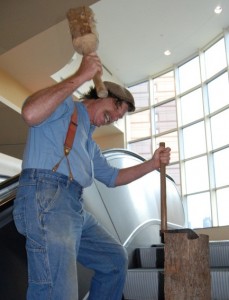
This is Roy at a WIA conference splitting logs on an escalator. He sure is nuts for his Froe! Â Photo used with permission (c) Peter Follansbee
Fast forward a little bit, we’re on the road (through the woods and over the hills to grandmothers house we go) for Thanksgiving and we stop in at a couple Antique store  along the way.  Of course what did I find?  An old beat up froe.  In fact there were two of them, but the second one was pretty bad.  I caved, I did I will admit it freely, I bought the froe  just to have it in my shop, as a sort of homage to Roy and all his work.  Plus, if I ever do run across a white oak straight grained log about six feet long, I’ll be set!  (The latter is very unlikely to happen out here on the West Coast in very urban Seattle, but you never know right?)
On the way back, travelling on Black Friday towards home we stopped at a new Antique store in eastern Washington we’d discovered while stopping for gas and lunch. Â It was a great store and my wife found some good stuff, and I got what I consider to be my best find so far.
In a dark corner, I found a pile of rusty junk  that contained a beat up Stanley Number 7 whichlooked like it might be salvageable.  As mentioned in a previous post I needed a new blade for my Number 7. so I thought I might be able to use it for parts at least.  As I carried it around for a while and in some better lighting I got a really good look at it and discovered the blade was in good shape and the rust wasn’t that bad.  The real kicker was the price tag, $25.  And I even got 10% off that just for asking.
Fast forward again to tonight when I got some time down in the garage to see what was under the rust and grime. Â It was a veritable diamond in the rough because the rust was barely surface level and the grime scrubbed way to reveal a pretty solid user plane. Â I hit it with some light machine oil, sand paper and a wire brush and this is what came out.
I had to completely regrind the blade because it looks like someone had planed some nails with it and a quick run through my Coarse, Medium, Fine India stones followed by Translucent Arkansas and stropping I have a blade that could shave hairs off my arm and cut wispy thin shavings.  There was grime deep in the works, and I had to totally disassemble it and give it a thorough cleaning.  There was paint splatters in all sorts of places including a big old dollop on the front knob.  I sanded the knob on my lathe and cleaned up the tote handle by hand followed by a light coat of walnut oil.
Best $25 I’ve ever spent.
Tools at the Royal BC Museum
This weekend the family indulged in a quick get-a-way to Victoria, BC for a quick vacation.  It’s only a few hours ride on the Victoria Clipper, and was nice and relaxing for us to get away from work and the messy house.  While we were traipsing around the Royal British Columbia Museum I ran across a few woodworking related displays and interesting tools I thought I would share.  Overall the Museum is a fun trip, especially with kids, as the displays are really well done and not at all boring.
In one of the “through the periods of history” sections they have this great display of hand tools on the wall that any woodworker would love to have.
Some were more modern, but some were nice looking vintage pieces that would great additions to the toolbox.
Further down the display they had an interesting saw in a kit for a surgeon. I snapped a picture because it looked like it would make a great handle design for a dovetail saw.
The over in the native peoples exhibit they had a nice display on how they made the bentwood and carved boxes out of Cedar.
We had a great time, and my son loved the undersea area which is done in a very steampunk, 20,000 leagues under the sea theme that is superb, and the giant Mammoth display. Â He ended up with a stuffed Mammoth to take home which he was quite happy with.
Replacing the Blade on a Stanley #7
I dug out one of my rehab projects the other day, and did some more with it. Â I have this old Stanley #7 in need of some TLC. Â I took it apart to clean out the gunk, and flattened the surfaces where metal meets metal. Â Things were pretty rough, but cleaned up pretty well. Â All in all I was feeling pretty good about it, until I got to the blade.
Ugh. Â No amount of grinding on the stone is going to fix this blade. Â There is so much pitting on the back, I could sharpen for ages and it will have some nicks somewhere. Â I’m giving up on this one, and asking for advice how to upgrade this to a better blade.
Does anyone have any suggestions on a good replacement blade? Â I’ve always heard of Hock blades, but have never tried fitting a bigger blade in an old plane before. Â I’ve also seen a few new blades being offered from Woodcraft and Lee Valley that might be worth looking into.
Help?
Here is the rest of the body and parts.
I think this plane has a lot of life left, but that blade has to go.  I’m going to give the rest of the body a solid cleaning, and see what I can get out it.  The body is pretty solid, no cracks and a pretty flat sole.  It will be a solid user once I get a new blade.
Badger


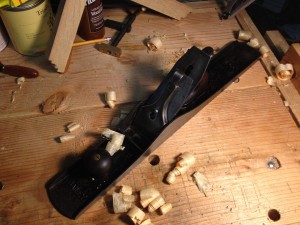
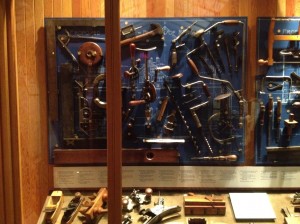
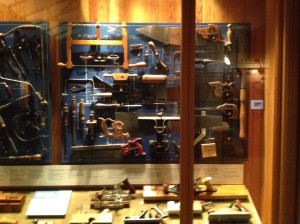
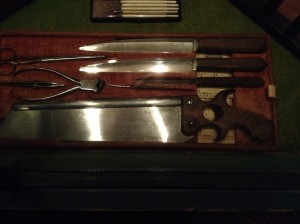





You must be logged in to post a comment.